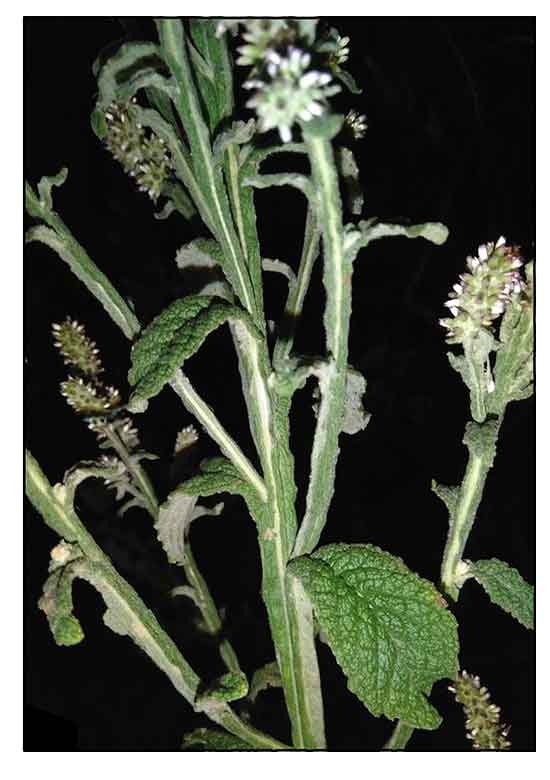 Gen info Gen info
- Pterocaulon is a genus of flowering plants in the sunflower family.
- The genus name Pterocaulon derives from Greek words fpr "winged stem", referring to the unique leaf bases that extend down the stems, resembling wings.
(7)
Botany
Sambong-gala is a woolly, erect, branched herb, 0.5 to 1 meter in height, with stems bearing very conspicuous longitudinal wings. Leaves are alternate, stalkless, lanceolate, 3 to 7 centimeters long, and toothed at the margins. Heads are small and borne in large numbers on the upper parts of the branches. Flowers are pink to purplish.
• A perennial, aromatic herb up to 100 cm tall; stems conspicuously winged, variably grey-hairy. Leaves alternate, simple, oblanceolate, (2-)3-5(-7) cm × 0.7-2 cm, base cuneate, apex acute or obtuse, denticulate to almost entire, densely woolly above, thinly so below; petiole with decurrent wings; stipules absent. Inflorescence composed of small heads c. 4 mm long, forming terminal spike-like clusters 2-5 cm × 0.8-1 cm; outer involucral bracts oblong, shortly apiculate, densely woolly, inner ones much longer, glabrous, falling off together with the flowers. Flowers all tubular; marginal flowers female, numerous, 2-3 mm long, with slender corolla, entire or very shallowly toothed; disk flower bisexual, solitary, corolla cylindrical, 5-lobed, lobes papilose outside; stamens 5, anthers fused; ovary inferior, 1-celled, style with 2 filiform arms, exserted in female flowers. Fruit an oblong achene c. 1 mm long, obscurely angular, glabrous to pubescent; pappus hairs thin, c. 2 mm long, dentate. (2)
 Distribution Distribution
- Native to the Philippines.
-
In open waste places at low and medium altitudes in Lepanto and the Benguet Sub-provinces, Cagayan, Ilocos Norte, Pangasinan, Bataan, and Batangas Provinces in Luzon, and in Mindoro, at low to medium altitudes.
- Also native to Cambodia, China, Hainan, India, Laos, Myanmar, New Caledonia, New Guinea, New South Wales, Queensland, Thailand, Vanuatu, Vietnam.
Constituents
- Study of aerial parts yielded seven coumarins: 5-methoxy-6,7-methylenedioxycoumarin (1), ayapin (2), puberulin (3), 5-methoxyscopoletin (4), 2',3'-dihydroxypuberulin (5), isofraxidin (6), and 5-(2',3'-dihydroxy-3'-methylbutyloxy)-6,7-methylenedioxycoumarin (7), and three flavonoids, luteolin (8), tomentin (9), and chrysosplenol C (10). (see study below) (1)
- Study of aerial parts of Pterocaulon redolens provided one new natural coumarin, namely, 2',3'-dihydroxypuberulin, six known coumarins identified as 5-methoxy-6,7-methylenedioxycoumarin, ayapin, sabandinol, puberulin, 5-methoxyscopoletin and isofraxidin, and also gave three known flavonoids, chrysosplenol C, luteolin and tomentin.
Properties
- Studies have suggest anticancer, antimycobacterial properties.
Parts used
Leaves
Uses
Folkloric
- Decoction of leaves used for stimulant baths.
- In Nueva Ecija, a mix of leaves of subusob and lagundi used to treat high fever. (6)
- Indigenous people of Santol, La Union use leaves for treatment of fever, headache, flu, cough, and difficulty of urination. (8)
Studies
• Phytochemicals / Anti-Mycobacterial / Anticancer / Aerial Parts: Studies on the chemical constituents of the aerial parts of Pterocaulon redolens isolated ten components: seven coumarins and three flavonoids. Six coumarins (1-4, 6 and 7) and one flavonoid (8) displayed mild activity against Mycobacterium tuberculosis H37Ra. One flavonoid (10) possessed moderate cytotoxicity against breast cancer and human small cell lung cancer (NCI-H187) cell lines. (see constituents above) (1)
• Coumarins / Cytotoxicity / Anti-Leukemia Potential: Among the coumarins present in Pterocaulon species, 5-methoxy-6,7-methylenedioxycoumarin, found in Pterocaulon redolens, P. alopecuroides, P. balansae, P. polystachyum, P. serrulatum, and P. virgatum, is the most studied, a compound which has shown cytotoxicity against glioma cell lines and was able to induce markers of cell differentiation, suggesting a potential therapeutic application in the management of leukemia. (5)
Availability
Wild-crafted.
|

![]()




 Distribution
Distribution